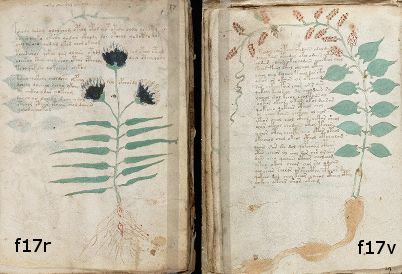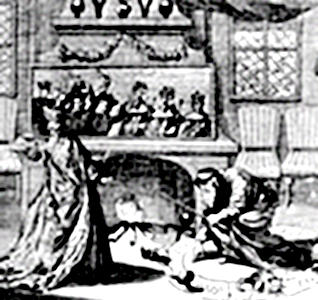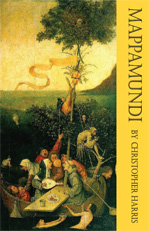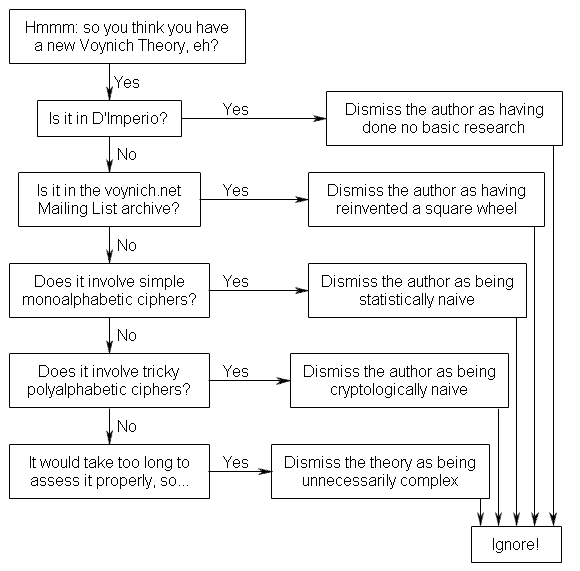Halfway through Blunt and Raphael’s “The Illustrated Herbal”, a small lightbulb flickered briefly to life in my tired head. And it was to do with the VMs’ Occitan marginalia, something that has bugged me for years…
To my codicological eyes, the VMs appears to have had a busy time in the 15th century (with three or four inquisitive owners), a very quiet time for most of the 16th century, before an intense flurry of activity circa 1600 (when I think its folios were numbered and the “heavy paint” layer added), which is just about when its semi-documented life at the Rudolfine court begins.
But, like an alcoholic after a particularly mad binge, there’s a whole chunk of time missing in the middle – in fact, about a century’s worth. What happened then? Who owned it? How did the VMs apparently get from Occitania (probably Southern France) to Prague? And – most crucially of all – why did nobody think fit to mention such an intriguing object?
Now: even though in many ways I hate what I call “join-the-dots histories”, when evidence is completely lacking (as is the case here) you really don’t have much choice. Basically, pragmatic hypotheses (which historians need so as to be even remotely strategic about what they look to for evidence) have to come from somewhere: and so here is my (possibly new) suggestion for how the VMs travelled from Northern Italy to Southern France and onwards towards the Rudolfine Imperial court at Prague. It may be rubbish, but it is at least testable rubbish. 🙂
The dots I propose to conveniently join together in a line (along which the VMs might well have travelled) are:-
- Guillaume Pellicier [or Pellissier, or Pelicier] (c. 1490–1568), Bishop of Montpellier, who was a French diplomat in Venice between 1539 and 1542, from where he brought back Greek, Hebrew and Syriac books. He was also interested in botany; was imprisoned for a while (it’s a long story…); and was a long-time patron and friend of….
- Guillaume Rondelet [or Rondeletius] (1507-1566), who famously taught medicine and botany at the University of Montpellier, and wrote a definitive book on fish. Rondelet bequeathed his collection of manuscripts to his student…
- Matthias [de] L’Obel (Lobelius), (1538-1616) a young (but soon to be famous) botanist; he travelled to the North, settling first in Holland, then England, then Holland, and then England again.
From there you can get the VMs to Prague in any number of ways, though many (of course) would like it to have been carried there by Dee & Kelley. While that last part is still in the realms of wishful thinking, I’m more interested here in working out if the Montpellier side of things might be true… but how?
Further reading-wise, here are the lowest hanging fruits of all: HTML text resources.
- I’ve placed a copy of Rev. Charles Kingsley’s chapter 14 of “Health and Eduction” (1874) “Rondelet, The Huguenot Naturalist” on the Cipher Mysteries website here. By modern standards, the text is a bit cloying, let’s say: but an OK starting point nonetheless.
- A relatively up-to-date summary of Guillaume Rondelet’s life (in French) is here.
For correspondence, all three men have stuff in various archives: Pellicier’s Venetian correspondence, Rondelet’s (mainly medical) letters were published in his “Opera Omnia Medica” (?), while L’Obel (from whose name we get “Lobelia”, incidentally) similarly has a few letters out there (his patron Baron Zouche, the 16th century apothecary Jean Mouton, etc).
As with most questions about French letters, Gallica has plenty of scans of creaky old books which may (or may not) be useful. Here are some quick links to start with, sorted by date (rather than by usefulness):-
-
1554: Libri de piscibus marinis, in quibus verae piscium effigies expressae sunt. Rondelet, Guillaume. Matthiam Bonhomme (Lugduni). Online here.
-
1557: Histoire des plantes, en laquelle est contenue la description entière des herbes… non seulement de celles qui croissent en ce païs, mais aussi des autres estrangères qui viennent en usage de médecine. Dodoens, Rembert (1517-1585). Impr. de J. Loe (Anvers). Online here.
-
1572: Illustrations de Commentaires de M. Pierre André Matthiole, médecin Senois, sur les six livres de Ped. Dioscoride anazarbeen de la matière médicinale. Mattioli, Pierandrea (1500-1577). Guillaume Rouillé (Lyon). Online here.
-
1579: Nicolai Dortomanni Arnhemij Libri duo. De causis & effectibus thermarum belilucanarum. / Carmina G. Salmuth, C. Heintzelij, A. Widholtzii. Dortoman, Nicolas. Apud Carolum Pesnot (Lugduni). Online here.
-
1581: Plantarum seu Stirpium icones. De Lobel, Matthias. C. Plantini (Antuerpiae). Online here.
-
1841: Notes et documents pour servir à l’histoire de Lyon, 1483-1546. T. 1. Péricaud, Antoine (1782-1867). impr. de Mougin-Rusand (Lyon). Online here.
-
1877: Étude historique sur l’École de droit de Montpellier, 1160-1793, d’après les documents originaux,… Germain, Alexandre-Charles. Boehm et fils (Montpellier). Online here.
-
1903: Les ambassadeurs français permanents au XVIe siècle. Vindry, Fleury. H. Champion (Paris). Online here. (Text starts on page 5)
-
1911-1914 Bullaire de l’église de Maguelone. [Volume 1]. Rouquette, Julien (1871-1927). Online here.
Books to look at for Guillaume Pellicier (note the various spellings!) would seem to be:-
-
1886: Catalogue des manuscrits grecs de Guillaume Pelicier évêque de Montpellier, ambassadeur de François Ier à Venise. Henri Auguste Omont. A. Picard, Paris. In the Internet Archive here.
- 1891: Inventaire de la bibliotheque de Guillaume Pelicier, eveque de Montpellier (1529-1568). Henri Omont, in Revue des Bibliotheques, I, pp. 161-172. “Inv. used. Montpellier. Clergy, booklist printed”, according to this page on French wills. Gallica has apparently not yet scanned the 1891 edition (while the earliest currently on Google Books is 1897), which is a huge shame as this is the first place I’d like to look… oh well. 🙁
- 1899: Correspondance politique de Guillaume Pellicier: ambassadeur de France à Venise 1540-1542. Tausserat-Radel, Alexandre (1858-1921). Paris, F. Alcan.
- 1969: La diplomatique francaise vers le milieu du XVIe siecle, d’apres la correspondance de Guillaume Pellicier, eveque de Montpellier, ambassadeur de Francois Ier a Venise 1539-1542. J. Zeller. Slatkine Reprints.
- 1986: Les copistes de Guillaume Pellicier, éveque de Montpellier <1490-1567>. Annaclara Cataldi Palau, in Scriptorium 40, pp. 225-237. According to this website, “The author’s research on the Greek manuscripts in the library of Guillaume Pélicier, the French ambassador to Venice between 1539-42, relied heavily upon analysis of the watermarks to supplement other palaeographical and documentary evidence“
- 1986: Les vicissitudes de la collection de manuscrits grecs de Guillaume Pellicier. Annaclara Cataldi Palau, in Scriptorium 40 (1), pp.32-53
- ????: Manoscritti greci della collezione di Guillaume Pellicier, Vescovo di Montpellier (ca. 1490-1568) : “Disiecta membra”. (I don’t know where it’s from, but ULRLS has a copy).
(Incidentally, Annaclara Cataldi Palau is a Professor at King’s College London, whose research interests are “Greek palaeography and history of book production“: so I presume that the last article was placed in the University of London Library system directly by her, in case you can’t find it anywhere else.)
Books which tend to get cited on Guillaume Rondelet are:-
-
1582: Vita Gulielmi Rondeletti, L. Joubert [Rondelet’s first biographer], in Opera Latina, 2 (Lyon, 1582), pp. 186-93. [Nancy Siraisi briefly discusses Joubert’s account in her “History, Medicine, and the Traditions of Renaissance Learning” (2007), pp.126-127]
-
1865: Rondelet et ses Disciples ou la botanique à Montpellier au XVIe siècle. Discours prononcé dans la séance solennelle de rentrée des Facultés et de l’École supérieure de pharmacie de Montpellier, le 15 novembre 1865 par J.-E. Planchon, directeur de l’École de pharmacie. If you’re interested, there’s a copy on AbeBooks for a paltry £363.04: or you can go to the Natural History Museum’s library instead (which is what I plan to do). 🙂
-
1899: La botanique en provence au XVIe siecle, II, Pierre Pena et Mathias de Lobel. L. Legré (Marseilles).
- 1926: Un manuscrit médical du XVIe siècle, contenant principalement des œuvres de Guillaume Rondelet: Notes bibliographique et biographiques, Suzanne Solente (with E. Jeanselme and Dr. M. Lanselle), in Bulletin de la Societe Francaise d’histoire de la Medecine, 20. pp. 3-36
-
1936: Guillaume Rondelet, J. M. Oppenheimer, in Bulletin of the Institute of the History of Medicine, 4, pp. 817-34.
- 1965: Guillaume Rondelet, C. Dulieu, in Clio medica, 1, pp. 89-111.
I’ll return to Lobelius another day (I’m still reeling from all the above). As it is, I’ve already jeopardised my membership of the Bloggers Union by including too much useful information in a single post. :-O



